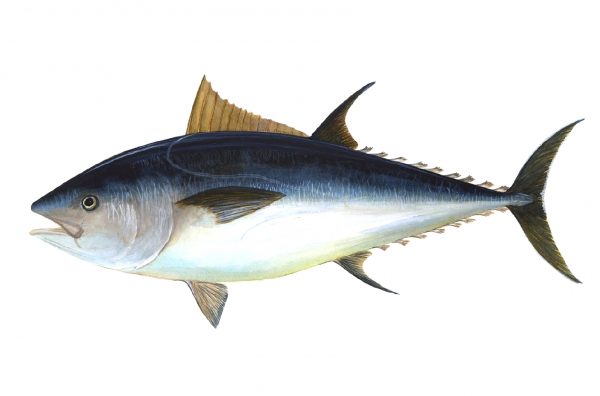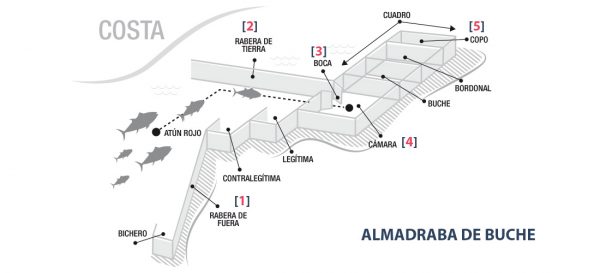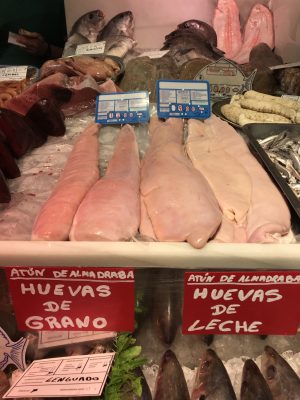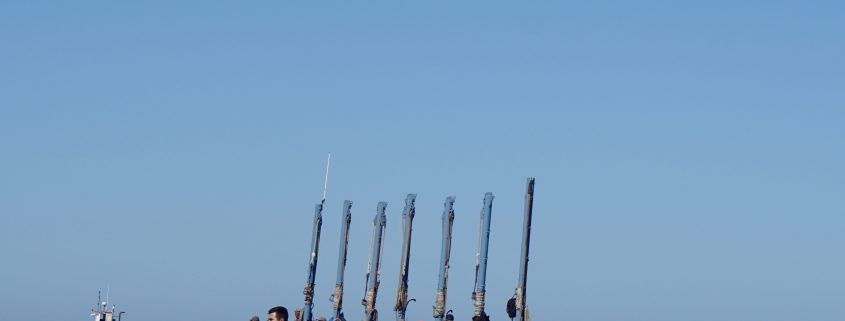Blue Fin Tuna Facts – The Spring Almadraba in South West Spain

BLUE FIN TUNA & ALMADRABA FACTS
- The Almadraba is an ancient method of catching the migrating Blue Fin Tuna off the coast of SW Spain. It was devised thousands of years ago by the Phoenicians using an elaborate maze of nets held in place by huge anchors.
- Lasting approximately 6 weeks from the end of April – beginning of June, or until quotas are reached.
- A sustainable method of fishing as, the smaller tuna can swim through the apertures of the nets and only the larger tuna are caught, allowing the smaller tuna to reach reproductive maturity.

- There are 4 Almadraba traps set off the coast of SW Spain – Conil, Barbate, Zahara & Tarifa. Barbate is the hub of all tuna activity and also home to the tuna temple of Spain – El Campero.
- In Spain, Blue Fin Tuna is referred to as Atun Rojo.
- The average size of the tuna captured is 180-200kg and the average age is 14 years. Tuna can live for up to 40 years and weigh as much as 900kg. In 2019 the average size was 240kg.
- The natural habitat of Blue Fin Tuna is the cold waters of the Atlantic and Pacific Oceans. Yellow fin live in warm water.
- Each Spring Mother Nature sends these giant fish torpedoing at up to 70 mph in search of warmer waters in which to spawn. The Atlantic tuna head to either the Gulf of Mexico or the Mediterranean. Like salmon, tuna return to where they were born, to spawn.
- Mother Nature also has a hand in fishing activity. When strong Levante blows, it’s impossible for the Almadraba boats to come together to lift the nets
- Spawning is when the females release their eggs, then the males come along and release their sperm, a normal procedure in the aquatic world.
- Blue Fin Tuna are warm-blooded fish and they build up blubber to keep warm whilst they live and feed in the chilly depths of the Atlantic. It’s this blubber that results in the tuna melting in your mouth like butter.
Why is Blue Fin Tuna is so expensive;
- Tuna are tremendous predators with huge appetites (herring, sardines, squid etc) but during the migration, their tummies are so full of eggs or sperm they have no room for food, hence the urgency to dump their eggs/sperm and start feasting as soon as possible. Therefore during the entire journey, they are fasting and detoxing which results in their flesh being completely pure – you are what you eat.
- The blubber built up to keep warm in the chilly Atlantic infuses the flesh and gives a melt-in-the-mouth, buttery texture when eating. Think of Iberian pork infused with acorn fat.
- The largest purchaser of the Almadraba caught tuna is the Japan. 50 years ago they realised that the coast of Cadiz was a tremendous source of prized bluefin tuna. They come in massive freezer ships to take home this “red gold”. They also set the current rules for how the tuna is dispatched because if an animal struggles in death, the meat will toughen and the blood warms, spoiling the meat. Once the “copa”(final net) has been lifted, snorkelers dive in and stun the tuna before they are lifted onto the boats where the jugular vein is then cut.
- Sea – butchery – freezer. For annual restaurant supply and shipping to Japan, the tuna will be out of the sea for a maximum of 2 hours before being frozen at -60. This is the temperature of cryogenics guarantees a prime product. This way, the tuna stay “fresh” for years and upon eating tastes as if it was caught yesterday.
- The butchery of these tuna is referred to as a “ronqueo”. This comes from the Spanish verb, ronquear – to snore. When the tuna butchers bring the knife down the backbone, it can sound like snoring – the snoring of the tuna. In Spain, public ronqueos during the Almadraba season are exciting celebrations of the arrival of the Blue Fin Tuna.
- These massive tuna are butchered into at least 22 different parts; from the prized belly to the simple sperm. Even the head has 5 different parts to it. To watch a team of 40 ronqueadores in action is a phenomenal sight. Speed is of the essence.
- At local markets, Blue Fin Tuna is only available fresh during the Almadraba season, and if you are buying it to eat raw you are now told to freeze the raw tuna beforehand. Freezing & cooking kills the parasite anisakis which the tuna, and other fish, are believed to carry.
- Each part of the tuna has a different value, the most valuable part being the belly and the surrounding area as that’s where the fat is. The cheapest is the sperm “huevas de leche”. Huevos = birds eggs / Huevas = fish eggs.

- The preservation of Blue Fin Tuna is an ancient art and unique to this area of Spain. Preserved tuna products using local methods preceded canning by centuries. Using the geographic elements of the sea air, salt, olive oil and pork fat, the resulting preserved tuna products are local delicacies worshipped by locals and gourmands. There are tuna preserve factories in Barbate processing/preserving yellowfin tuna from the Indian Ocean outwith the Almadraba season.
Mojama – air-dried tuna
Atun en Manteca Iberica – tuna preserved in Iberian Pork Fat
Ijada en Aceite – the belly preserved in olive oil



